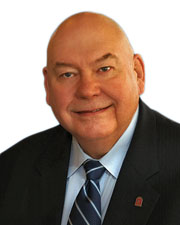
Commercial Classroom: Examining challenges faced by office market - by Ed Smith

This column is offered to help educate agents new to commercial and investment brokerage and serve as a review of basics for existing practitioners.
There is tremendous speculation within the industry as to what future office space will look like and how it will be used.
Probably the biggest challenge is what will become of the “work-at-home” concept. At the height of the COVID-19 pandemic, Co-Star reported the 62% of American employees were working from home. Some workers liked the flexibility, but others found it difficult, especially parents who also had to home school their children at the same time.
Another factor is the commute or lack thereof. The Urban Land Institute did a study which showed an average of 227 hours a year saved by not having to commute. In addition to the time saved, there were cost savings; health and exposer concerns by those who take mass transit and the reduction of vehicular traffic, which was a plus for the environment.
Our younger generations, many living in small or shared apartments or at home with parents are eager to get back to working in the office building environment. According to Emerging Trends in Real Estate the office atmosphere offers more opportunities for collaboration, learning and making business and social connections.
A survey by Deloitte found that 68% of employers plan to implement some type of hybrid workplace model this year. With a consensus leaning to working-at-home two days a week and staff rotation in the office the other days. This also adds to the overall concept of social distancing by reducing the daily number of employees in the space.
As we start looking at the physical office design the primary concern is indoor air quality, ventilation, and filtration. This cost burden will fall on the building owners, but employers are concerned for the health and safety of their workers. This may mean upgrading HVAC systems, putting higher caliber filters in place, or even building redesigns to include operating windows.
The pandemic put new focus on virtual technology, this will continue to be a permanent part of new business models. According to a report by JLL, offices will need more conference rooms or the smaller version “huddle rooms” to provide multiple areas for video conferencing or presentations. They also see more office plans with bench style seating to enhance collaboration, fewer enclosed private offices, open workstations available on an as-needed basis, no more assigned desks. Other permanent post-pandemic designs will include hand-sanitizing stations, touchless technology, and other social distancing measures.
A Cushman and Wakefield report points out the key word is workplace flexibility. Companies are still trying to figure out what to do with the remaining uncertainty about the virus and the work-at-home population.
Some companies headquartered in cities are considering hub-and-spoke models by opening satellite offices in the suburbs where their workers live. This would shorten their commute and, in many cases, eliminate concerns for taking mass transit. The number of employees working in these “outposts” would also be reduced aiding future social distancing workplace designs.
Will office vacancies continue to increase? According to Co-Star report as of the second quarter 2021, national office vacancy had exceeded 12%, up 2% over the same time in 2020. No one really has all the answers yet; let us hope that this pandemic finally gets controlled.
Another challenge for office employers is a shortage of labor and the increase in “job-hopping.” They are focused on attracting new hires and retaining talented employees. The office designs need to cater to what workers want today and offer other building amenities.
Employees want to be energized and connected thru shared meeting spaces and flexible open spaces. They want to be able to engage with others and at the same time feel safe and comfortable in the office environment. Today’s employee, after a year of working at home, needs to retain some of that freedom; to get outside of the “box.” Perhaps a roof top lounge might give them the break they need. Or that flexible work schedule with two days still work-at-home.
Employers have many challenges, and it will take time to sort out what the new normal will be; and it will not be the same for every company. Hence the “job-hopping” is expected to continue for some time.
Edward Smith, Jr., CREI, ITI, CIC, GREEN, MICP, CNE, e-PRO and CIREC program developer, is a commercial and investment real estate instructor, author, broker, speaker and a consultant to the trade.